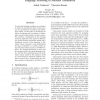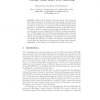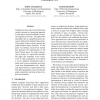197 search results - page 12 / 40 » Word Clustering and Disambiguation Based on Co-occurrence Da... |
ACL
2008
13 years 9 months ago
2008
In statistical language modeling, one technique to reduce the problematic effects of data sparsity is to partition the vocabulary into equivalence classes. In this paper we invest...
AUSAI
2007
Springer
13 years 11 months ago
2007
Springer
Abstract. This paper describes and compares the use of methods based on Ngrams (specifically trigrams and pentagrams), together with five features, to recognise the syntactic and s...
CICLING
2007
Springer
14 years 1 months ago
2007
Springer
Distributions of the senses of words are often highly skewed. This fact is exploited by word sense disambiguation (WSD) systems which back off to the predominant (most frequent) s...
CIS
2005
Springer
14 years 1 months ago
2005
Springer
Different from familiar clustering objects, text documents have sparse data spaces. A common way of representing a document is as a bag of its component words, but the semantic re...
NAACL
2007
13 years 9 months ago
2007
Graph-based semi-supervised learning has recently emerged as a promising approach to data-sparse learning problems in natural language processing. All graph-based algorithms rely ...



